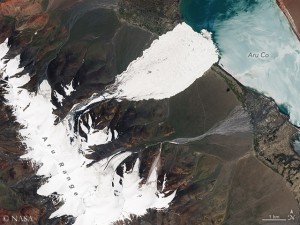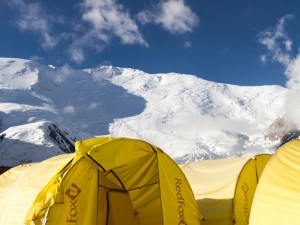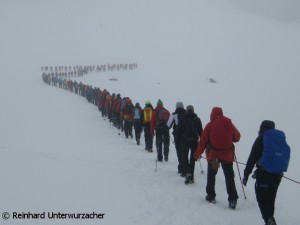Search Results for Tag: glacier
Huge ice avalanche in Tibet
This summer a mega ice avalanche has swept down on the Tibetan plateau. In the Aru Range in northwestern Tibet a whole glacier tongue broke off and tumbled down into the valley. Scientists say it was one of the largest ice avalanches ever recorded. According to the Chinese authorities this natural event, which already occurred on 17 July, killed nine Tibetan herders. More than 350 sheep and 110 yaks were buried under the ice and rock masses. The American space agency NASA now published satellite images which show the dimension: The ice covered an area of ten square kilometers, the lake down in the valley was colored white and the debris piled up 30 meters in some places. The cause of the collapse is still unclear. “Climate change is causing more glacial hazards through mechanisms we do not fully understand,” said the Chinese glaciologist Tian Lide. “There is an urgent need for more monitoring and research efforts, especially in populated areas in high mountains.”
I called the Swiss scientist Samuel Nussbaumer. The 35-year-old glaciologist is working for the World Glacier Monitoring Service (WGMS) in Zurich, which is observing and analyzing the fluctuation of glaciers worldwide.
![]() read more
read more
After 16 ½ years: Alex Lowe’s body found
Glaciers are constantly moving. And so they spit out one day what they once swallowed. Climate change, which makes glaciers melt faster, is speeding up the process. In recent years there have been more and more reports from around the world that bodies of dead climbers were discovered after many years. Whether on Mont Blanc, on the Matterhorn, on Mount Everest – or now on the eight-thousander Shishapangma in Tibet. The Alex Lowe Charitable Foundation announced that Swiss Ueli Steck and German David Goettler had discovered the bodies of two climbers in blue ice during their acclimatization for Shishapangma South Face. The melting glacier would release the corpses soon. The description of clothes and packs left no doubt that it was the bodies of Alex Lowe and David Bridges, it was said.
![]() read more
read more
Deadly accident on Peak Lenin
“There are no easy mountains and certainly no easy seven-thousanders.” I remember very clearly these words of my Austrian expedition leader Herbert Wolf in 2011, on the 7,246-meter-high Putha Hiunchuli (Dhaulagiri VII) in Nepal. I had to turn around 150 meters below the summit because the weather conditions were deteriorating and I was too late. What Herbert meant, was the fact that the conditions can change even an apparently easy mountain into a difficult and dangerous one.
Commercial expedition operators often call Peak Lenin in Kyrgyzstan an “easy seven-thousander” or an “entry seven-thousander”. On 7 August, a Russian mountain guide died on the 7,134-meter-high mountain in the Pamirs.
![]() read more
read more
Rope team of 193
The clouds were hanging low, it was cool. Not exactly the perfect weather to tempt curious or spontaneous people to climb up to over 3,000 metre to the Koednitzkees, a glacier below the summit of Grossglockner, the highest mountain of Austria. On Saturday – as reported here – the “longest rope team of the world” should be formed there. A notary certified the number of participants of the action which in case of success should find its place in the Guinness Book of Records. Despite the bad weather 193 mountain friends roped up to a length of 600 metres. “The exercise has been successful,” said Peter Ladstätter, district head of the mountain rescue in Osttirol (Eastern Tyrol) who had organized the event.
![]() read more
read more
Never without rope on a glacier
The longest rope team of the world. That is the goal of an action on Grossglockner, which, if it works, will find its place in the Guinness Book of Records. On Saturday at 2 p.m. mountain rescuers of Osttirol (Eastern Tyrol) will rope up as many climbers as possible on the Koednitzkees, a glacier below the highest peak of Austria. A notary is commissioned by the Guinness Book of Records to count the participants. Afterwards the Austrian artist Dieter Remler will make a performance, according to the motto: “As free as an eagle, with a person’s mind”. This is just one of several actions in Osttirol during this weekend which is dedicated to safety in the mountains . I contacted Peter Ladstaetter, district head of mountain rescue in Osttirol. He has organized the action on the Koednitzkees .
Peter, what is the message of forming the longest rope team of the world?
Our key message is: It must be a standard to take a rope before you enter or cross a glacier. Unfortunately many do not know that glacial ice is always moving and therefore also crevasses are “walking”. There are many falls which only end without serious consequences – in most cases even unhurt – because the mountaineers are roped up.
![]() read more
read more










Feedback